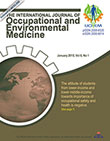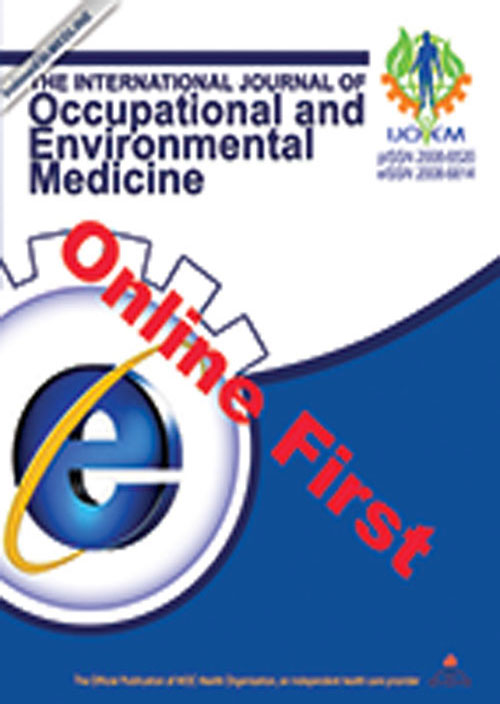فهرست مطالب

International Journal of Occupational and Environmental Medicine
Volume:6 Issue: 1, Jan 2015
- تاریخ انتشار: 1394/01/24
- تعداد عناوین: 9
-
-
Pages 3-6
-
Pages 7-19BackgroundWork-related diseases contribute immensely to the global burden of diseases. Better understanding of attitudes of health care workers towards occupational safety and health (OSH) is important for planning.ObjectiveTo assess the attitude of medical students towards OSH around the globe.MethodsA questionnaire assessing the attitude towards OSH was administered to medical and paramedical students of 21 Medical Universities across the globe. In the current study 1895 students, aged 1836 years, from 17 countries were included. After having performed a principal components analysis, the associations of interest between the identified components and other socio demographic characteristics were assessed by multivariate linear regression.ResultsPrincipal component analysis revealed 3 components. Students from lower and lower-middle-income countries had a more positive attitude towards OSH, but the importance of OSH was still rated higher by students from upper-income countries. Although students from Asian and African continents showed high interest for OSH, European and South-Central American students comparatively rated importance of OSH to be higher. Paramedical students had more positive attitude towards OSH than medical students.ConclusionThe attitude of students from lower-income and lower-middle-income countries towards importance of OSH is negative. This attitude could be changed by recommending modifications to OSH courses that reflect the importance of OSH. Since paramedical students showed more interest in OSH than medical students, modifications in existing health care system with major role of paramedics in OSH service delivery is recommended.Keywords: Health knowledge, attitudes, practice, Students, medical, Allied health personnel, Occupational health, Safety
-
Pages 20-25BackgroundHydrogen sulfide (H2S) exhibits both physiological and toxicological roles in the biological systems. Acute exposure to high levels of H2S is life threatening while long-term exposure to ambient levels of H2S elicits human health effects.ObjectiveTo study the harmful effects of long-term exposure to low levels of H2S on human blood cells.Methods110 adult workers from Iran who were occupationally exposed to 090 ppb H2S for 130 years were studied. The participants aged between 18 and 60 years and were exposed directly or indirectly to sulfur compounds (exposed group). The origin of H2S was natural gas processing plants. A control group consisting of 110 males who were not in contact with H2S was also studied. For all participants, hematological profile including total hemoglobin and red blood cell count and sulfhemoglobin, methemoglobin levels were measured.ResultsAmong all parameters evaluated in this study the mean methemoglobin and sulfhemoglobin levels were significantly higher among workers who were exposed to sulfur compounds than the control group. Major differences throughout the study period for sulfhemoglobinemia among exposed groups were observed.ConclusionLong-term exposure to even low levels of H2S in workplaces may have potential harmful effects on human health.Keywords: Hydrogen sulfide, Sulfhemoglobin, Methemoglobin, Hemoglobins, Erythrocyte count
-
Pages 26-33BackgroundExposure to blood-borne pathogens from needle-stick and sharp injuries continues to pose a significant risk to health care workers. These events are of concern because of the risk to transmit blood-borne diseases such as hepatitis B virus, hepatitis C virus, and the human immunodeficiency virus.ObjectiveTo benchmark different risk factors associated with needle-stick incidents among health care workers in the Ministry of Health hospitals in the Kingdom of Saudi Arabia compared to the US hospitals participating in Exposure Prevention Information Network (EPINet ).MethodsProspective surveillance of needle-stick and sharp incidents carried out during the year 2012 using EPINet ver 1.5 that provides uniform needle stick and sharp injury report form.ResultsThe annual percutaneous incidents (PIs) rate per 100 occupied beds was 3.2 at the studied MOH hospitals. Nurses were the most affected job category by PIs (59.4%). Most PIs happened in patient's wards in the Ministry of Health hospitals (34.6%). Disposable syringes were the most common cause of PIs (47.20%). Most PIs occurred during use of the syringes (36.4%).ConclusionAmong health care workers, nurses and physicians appear especially at risk of exposure to PIs. Important risk factors of injuries include working in patient room, using disposable syringes, devices without safety features. Preventive strategies such as continuous training of health care workers with special emphasis on nurses and physicians, encouragement of reporting of such incidents, observation of sharp handling, their use and implementation of safety devices are warranted.Keywords: Needlestick injuries, Benchmarking, Health personnel, Blood-borne pathogens, Occupational exposure
-
Pages 34-40BackgroundMetabolic syndrome (MSx) is associated with several health problems. Workers are an important part of any organization.ObjectiveTo determine the prevalence of MSx and related variables among office workers.MethodsThis cross-sectional study evaluated 1488 office workers in Qom province, Central Iran, by using a multi-stage cluster sampling. Diagnosis of MSx was based on blood HDL-cholesterol, triglyceride, and fasting blood sugar (FBS) levels and waist circumference, and blood pressure.ResultsThe overall prevalence of MSx was 35.9% (95% CI 33.5% to 38.3%), higher in men (37.2%) than in women (20.6%), and increased with age. The most common laboratory findings of MSx were hypertriglyceridemia (45.9%) and low HDL-cholesterol level (45.5%). Office workers with MSx had a significantly (pConclusionThe prevalence of MSx was very high among office workers. Workplace health improvement programs through identifying and preventing MSx are necessary for improvement of staff's health.Keywords: Metabolic syndrome, Prevalence, Occupational exposure, Obesity abdominal, Hyperlipidemias, Iran
-
Pages 41-49BackgroundWorkers in wastewater treatment plants are exposed to a wide range of chemicals as well as biological contaminants.ObjectiveTo ascertain whether exposure to bio-aerosols under the normal working conditions in wastewater treatment plants is associated with any significant changes in the prevalence of respiratory symptoms and lung function capacities.Methods198 employees of wastewater treatment plants and 99 unexposed persons were studied. American thoracic society (ATS) standard respiratory symptom questionnaire was used to determine the prevalence of respiratory symptoms. Pulmonary function tests were conducted for each participant.ResultsThe prevalence of respiratory symptoms among exposed persons was significantly higher than that of unexposed people. Mean values of most pulmonary function test parameters were significantly lower in the exposed compared to the comparison group persons.ConclusionIncreased prevalence of respiratory symptoms and decrements in pulmonary function test parameters may be attributed to exposure to bio-aerosols released from wastewater treatment plants.Keywords: Waste water, Environmental pollution, Respiration disorders, Respiratory function tests, Aerosols
-
Pages 50-57BackgroundThe interaction between serum neuron-specific enolase (NSE), biogenic amino-acids and neurobehavioral function with blood lead levels in workers exposed to lead form lead-acid battery manufacturing process was not studied.ObjectiveTo evaluate serum NSE and biogenic amino-acids (dopamine and serotonin) levels, and neurobehavioral performance among workers exposed to lead from lead-acid storage battery plant, and its relation with blood lead levels (BLLs).MethodsIn a cross-sectional study, we performed biochemical and neurobehavioral function tests on 146 workers exposed to lead from lead-acid battery manufacturing process. BLLs were assessed by an atomic absorption spectrophotometer. Serum NSE, dopamine and serotonin were measured by ELISA. Neurobehavioral functions were assessed by CDC-recommended testssimple reaction time (SRT), symbol digit substitution test (SDST), and serial digit learning test (SDLT).ResultsThere was a significant correlation (r 0.199, pConclusionSerum NSE cannot be used as a marker for BLL. The only domain of neurobehavioral function tests that is affected by increased BLL in workers of lead-acid battery manufacturing process is that of the attention and perception (SDST).Keywords: Lead, Enolase, Neuron-Specific, Dopamine, Serotonin, Neurobehavioral manifestations, Biogenic amines, Amino acids, Healthy worker effect
-
Upcoming Meetings (online only)Page 1


